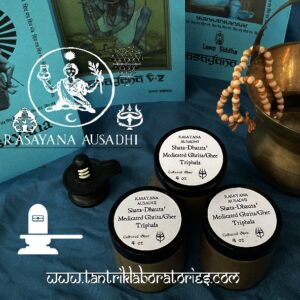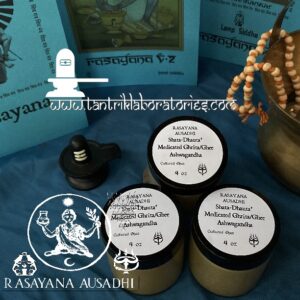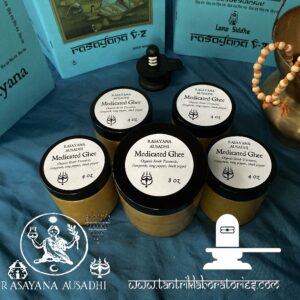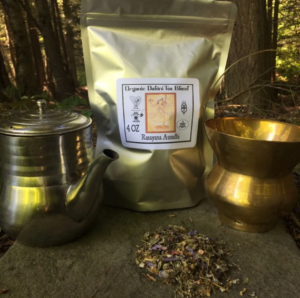Triphala is one of Ayurveda’s most famous herbal formulas for digestive health, which contains the superfood amalaki (also known as amla), along with bibhitaki and harataki. ghee an excellent anupana and its spreading nature can take the intention of herbs in to the deep tissues. We infuse organic, cultured ghee using the traditional Ayurvedic methods of slow, low heat, purifications in water and washing, that culminate in the purest, finest and most bioavailable product.
Triphala ghee is a tri-doshic option, meaning it is good for any dosha. Supports gentle detox, improves digestion, soothes the nerves, anti-inflammatory, aids in reducing belly fat, and improves eye health. Ghee increases agni, the digestive fire and beginning the day with triphala ghee is the catalyst for maximum gut health. According to Ayurveda, it improves the absorption ability of the small intestines and decreases the acidic pH of our gastrointestinal tract.. Increased agni can be viewed as an increase in energy expenditure. Triphala ghee is tri-doshic, or suitable for all types of dispositions. It is a gentle purification herb, scrapping the deep toxins in the intestines (ama), and with the triphala this is enhanced and thus improves digestion, soothes the nerves, is anti-inflammatory, and said to improves eye health, weight loss and other digestive issues. See below for detailed listing of the Triphala or three fruits.
Our organic herbs are infused into Grassfed Organic Cultured Ghee in our artisan line of small-batch traditional made in traditional copper vessels. We started this line with the Master Siddha herbalists of Ayurveda to produce the apex of medicated ghee or ghrita for maximum bioavailability. Indian or Desi ghee is the traditional Indian ghee made from cow’s milk that is first collected and saved for a few days to “culture”. The cultured milk is then churned to produce butter. Churning separates the emulsified fats in the milk from the liquid or aqueous portion of the milk. This is the most medicated ghee which is then washed and cleansed.
These are the best, efficient and bioabailable means of delivering herbal formula deep into the body, and are especially useful in gut health. Thus, this product is truly a yogavahi—a catalytic agent that carries the medicinal properties of herbs into the seven dhatus or tissues of the body. Ghee pacifies pitta and vata and is acceptable, in moderation, for kapha. Charaka Samhita. This means that they only produce their ghee from cultured butter, also known as Makhan. Makhan is made by transforming cream from cows (which are revered and considered sacred in India) into yogurt and then by churning the yogurt into butter. From there, cooking small batches of the cultured butter over an open flame to clarify the butter into ghee. This process of clarifying butter into ghee removes the milk fat solids, casein and lactose from the butter leaving only the healthy, ojas building fat which is known as ghee.
This process is called ‘Murcchana’ samskara (fat processing) is assumed as one of the crucial step in ghrita preparation entailing the use of ‘Murcchita’ ghee i.e. ghee prepared with incorporation of Murcchana herbs y ghritapaka (ghrita preparation), ghee should undergo ‘Murcchana’ samskara to enhance the medicinal potency of a ghrita and to get rid of bad odour and rancidity. ‘Shata-Dhauta’ is a process involves washing of purified ghee one hundred times with water which increases stability of ghrita and makes it elegant and suitable product for topical application cow ghee increases the potency of certain herbal ingredients by carrying the lipid soluble active components to the interior of the cell Ayurvedic texts. Briefly, the stated quantity of ghee (Sneha Dravya) was poured in a large stainless steel vessel and allowed to melt under moderate flame. Further, the plant extracts (Kalka) in equal proportion, water (Drava Dravya) and molten ghee (Sneha Dravya) were combined in specified ratio of 1:16:4 respectively in same vessel and boiling was initiated till the complete evaporation of moisture and appearance of characteristic features of ghrita. The whole process of ‘Ghrita Paka Kalpana’ was carried out on mild to moderate flame and continued until ‘Sneha Siddhi Lakshana’ was obtained. The ‘Sneha Siddhi Lakshana’ is of burning of paste (Varti) without crackling sounds and disappearance of froth (Phena) in ghrita To increase therapeutic quality, purity, efficacy and stability/shelf life, the prepared PHBG-I was optimized by processing with ‘Murcchana’ and ‘Shata-Dhauta’ samskara as per the ancient Ayurvedic procedures.
This batch is infused with Organic Triphala whichis the three fruits, composed of:
Amalaki (Phyllanthus emblica) also known as emblic, emblic myrobalan, myrobalan, Indian gooseberry, Malacca tree, or amla, from the Sanskrit amalaki and is used traditionally for healthy functioning of the liver, heart, brain, and lungs. It’s also a component of a popular Ayurvedic remedy called triphala. It is considered best among Rasayana, or Achararasayana and has names such as Shreepala or ‘fruit of prosperity,’ Shiva ‘auspicious, nectar’ Divyadhara ‘basis for divine quality’ and many other names meaning ‘arresting old age’, ‘mother like’ and ‘invigorating.’ It is held in such high esteem and is an ingredient in the famous Triphala or three fruits (with Terminalia bellirica and T. chebula). Triphala is one of the most widely used herbal formula and regular use is celebrated for removing waste and treating many common conditions such as arthritis, impure blood, obesity, general sickness, old age, headaches, eyesight and many other ailments that all cluster around cellular degeneration, inflammation and poor digestion and oxidative stress. Amalaki gives longevity, increased memory, balanced intellect, health and youthful energy, lustrous skin and body and it is also cherished as a psychic and spiritual medicine, imparting well-being, clarity, and peace with prolonged use. Such formula often combines ghee and honey with ashwagandha for a profound tonic formula and restorative. As well as being considered a nootropic for memory and intelligence, it is said to reduce the propensity for headaches, migraines and such tension and stress that causes and triggers such symptoms. It is a supreme digestive aid, expectorant for chronic coughs, is useful in diabetes, eye diseases and is used widely in hair tonics as well. Studies on its use as anabolic agent show positive effects on cellular regeneration, lean body mass, and balancing body weight. It is a well-studied potent antioxidant, digestive aid, antimicrobial, antimutagenic and immunomodulator exhibiting anti-tumor properties.
Haritaki (Terminalia chebula) is named Haritaki as from the ‘abode of Hara’ (Hara is a name for Lord Shiva). It is called Vijaya, victorious or conquers all diseases, Rohini, heals the wounds, Amrita, nectar, and too many other high titles to mention that hail this herb as giving long life, health, energy, sexual virility, divine blessings, peace and spiritual nourishment. It is the fruit held by Lord Buddha in his lap, as well as many of the sages from Padmasambhav and Nagarjuna, etc. These herbs are also used in the treatment of the holy mercury (parad) which is the ‘semen of Shiva’ and in the purification of the herbal-mineral and metallic medicines discussed in future issues of this series. It is superior for rejuvenation protocols, as its effect is like a mother’s care for the baby in the womb, providing pure nutrients and health. It is used for digestive aids, detox, purging ama wastes from the system, biofilms, bad blood, toxins and is a laxative in proper dosages but also regulates bowel movements. It is the most esteemed rasayana for longevity, for cardiotonic, spleen disorders, cholesterol, anti-cancer, anti-microbial, antiviral, and the most excellent immune boosting herb.
Vibhitaki (Terminalia bellircia) also called Bibhitaki is the third fruit in Triphala and another potent rasayana. Studies have shown its antimicrobial powers effective against strains of infections. Studies confirm folk uses for antifungal purges of Candida and is also beneficial in breathing and asthma. It is used in formula for deep breathing and pranayama and too many yogic formulae to mention in this brief entry. Its use for purging the body is effective in fasting protocols and priming to take the visionary herbs or the deeper medicines for maximum bioavailability. Bibhitaki belongs to the three main groups of herbs – Jwarahara, the herbs used to ease fever. Kasahara, herbs used to remedy cold and cough and Virechanopaga, herbs used in Panchakarma Detoxification. The ayurvedic formulation is well-known to pacify the Kapha and Vata doshas. Several studies have disclosed that bioactive compounds of the fruit are credited to have anti-depressant traits that are potent to combat stress and anxiety.
Entries of the three fruits of triphala are found in Rasayana V.1
To take ghee as a supplement, dissolve 1/2-1 teaspoon ghee in 1/2 cup warm water and drink it on an empty stomach. Cultured ghee is more refined and subtle than regular ghee, and thus able to penetrate deeply into your cells to deliver nourishment.




 Adding...
Adding...